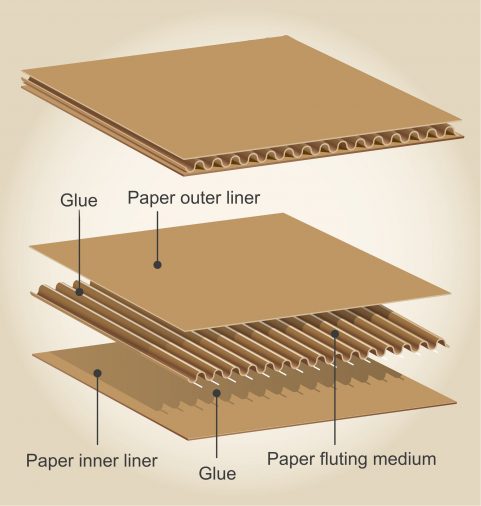Background
Most items at your favorite supermarket, discount store, or shopping mall were safely delivered in boxes made of corrugated cardboard, and many are displayed in the same boxes, which were manufactured so they could be opened and used for this purpose. Other items may arrive in their own corrugated or uncorrugated paperboard boxes. Because corrugated cardboard is such a versatile packaging material, millions of tons are used each year to protect and display products. During 1992, more than 25 million tons of corrugated cardboard were produced in the United States. Another 6 million tons of uncorrugated boxboard or paperboard were also produced for use in folding cartons.
Corrugated cardboard is a stiff, strong, and light-weight material made up of three layers of brown kraft paper. In 1884, Swedish chemist, Carl F. Dahl, developed a process for pulping wood chips into a strong paper that resists tearing, splitting, and bursting. He named it the kraft process because it produces a strong paper that resists tearing, splitting, and bursting.

From the paper mill, rolls of kraft paper are transported to a corrugating, or converting, plant. At the plant, layers of kraft paper are crimped and glued to form corrugated cardboard, which is then cut, printed, folded, and glued to make boxes. At the beginning of this process, kraft rolls from the paper mill are loaded into a huge machine called a corrugator. A typical corrugator is as long as a football field—300 feet (91.44 meters). Some rolls of kraft paper are used as the corrugating medium, and others are used as liners, the layers of kraft paper glued on each side of the medium. After the corrugator has heated, glued, and pressed the kraft paper to form corrugated cardboard, the continuous sheet of cardboard is cut into wide box blanks that then go to other machines for printing, cutting, and gluing. Finally, batches of finished boxes are banded together for shipping to the food processor, toy maker, automobile parts distributor, or any of the thousands of businesses that depend on corrugated cardboard packaging.
Raw Materials
Fast-growing pine trees provide the primary raw material used to make corrugated cardboard. The largest packaging companies own thousands of acres of land where trees are matured, harvested, and replaced with seedlings. After the trees are harvested, they are stripped of their limbs; only the trunks will be shipped by truck to a pulp mill. The largest packaging companies also own the mills where trees are converted to kraft paper. At the mill, the harvested tree trunks are subjected to the kraft process, also known as the sulfate process because of the chemicals used to break down wood chips into fibrous pulp. After pulping and other processing, the fibers are sent directly to the paper machine where they are formed, pressed, dried, and rolled into the wide, heavy rolls of kraft paper sent to corrugating plants to be made into cardboard.
At the corrugating plant, only a few other raw materials are needed to make a finished box. Corn starch glue is used to bond the corrugated medium to the liner sheets. Because so much glue is used, rail cars or large tanker trucks deliver it as a dry powder that will be stored in huge silos at the corrugating plant until it is needed. Drawn from the silo, the dry corn starch is mixed with water and other chemicals and pumped into the corrugator to be spread on the corrugated medium as the layers of liner are added. Other raw materials are used to finish the corrugated cardboard after production. Waxes made from paraffin or vegetable oils can be applied to make a water- or grease-resistant container for food products. Brightly colored inks are also applied to create bold graphic designs for self-supporting displays featuring product name, information, and company name and logo. Teams of salespeople and designers work together to create the manufacturing and printing patterns, called dies, that are used to cut and print a specific box design. The dies are created in a pattern shop and transferred to the rotary die-cutting equipment and printers that finish the box blanks.
Design
Kraft paper has been manufactured since 1906. Since then, pulp processing, paper making, and corrugating operations have been developed to a high state of efficiency and productivity. Today, in the corrugated cardboard industry, designers are creating innovative containers that require four-color printing and complex die-cutting. These innovative containers are designed with sophisticated software such as computer-aided design (CAD) programs, allowing a packaging designer to brainstorm different package designs before manufacturing begins. A designer using a CAD program can call up and modify different designs that have been stored in a computer design library. Thus, existing packages can generate new designs. Many retail stores use such light, strong, and colorful containers directly, as point-of-purchase displays.
Source: Made How
